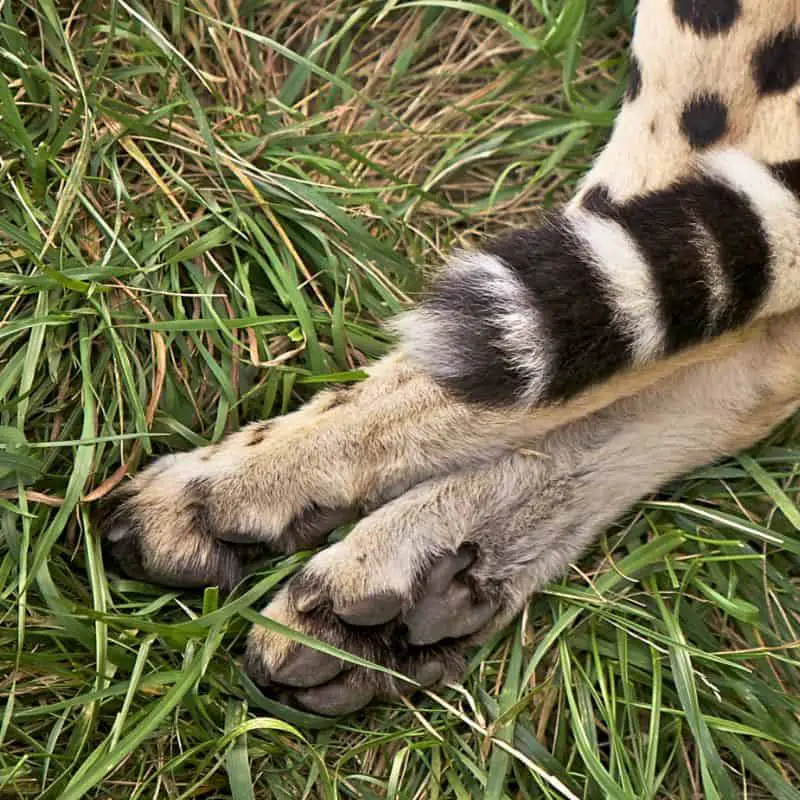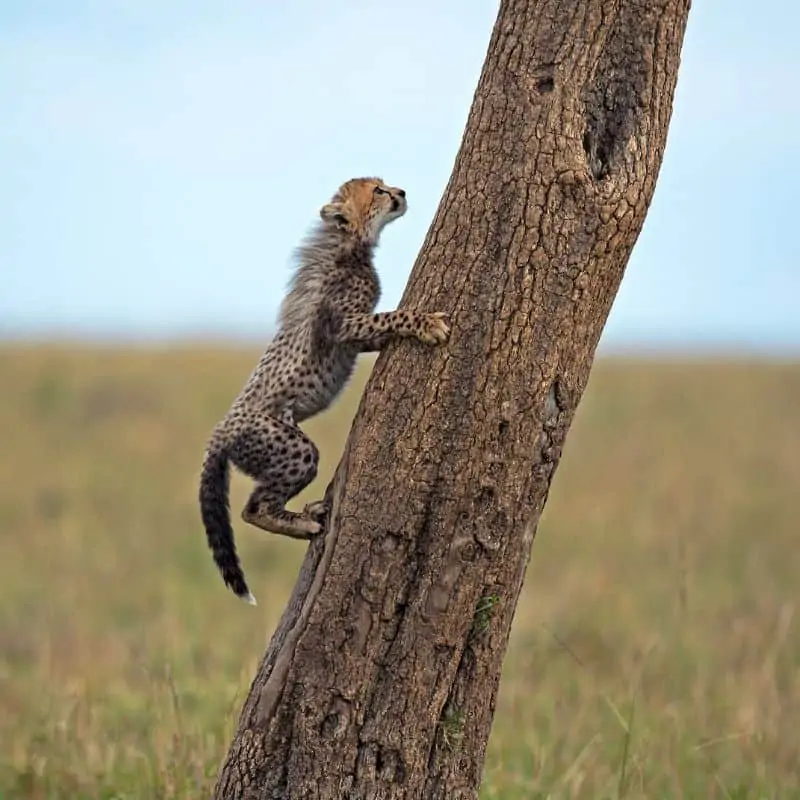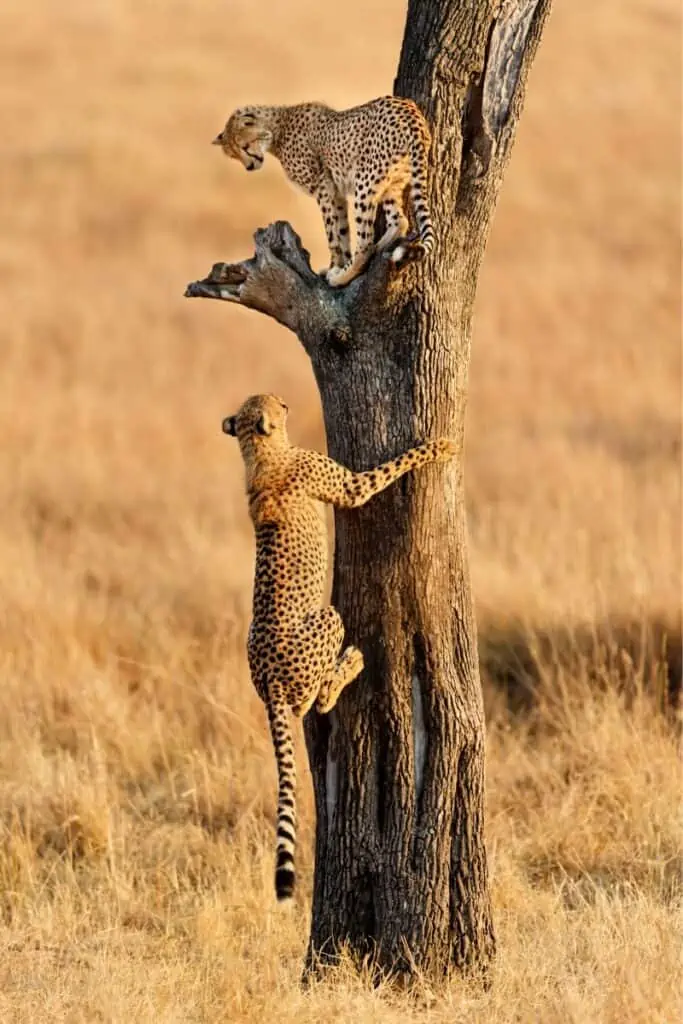Cheetahs are certainly remarkable animals. Between their running speed and unique sounds, you may start to believe there’s nothing they can’t do. As they’re so similar to domestic cats, can cheetahs climb trees, though?
Because of their musculature and non-retractable claw structure, cheetahs cannot climb trees as well as other members of the big cat family, such as leopards. Technically cheetahs can climb trees, but their ability is very limited, and they can’t haul prey up into a tree like a leopard can.
In this article, we’ll look at cheetahs’ climbing ability, comparison with leopards, and how cheetah cubs fare in the trees.

Can cheetahs climb trees?
Yes, cheetahs do have the ability to haul themselves up into a tree. But don’t make the mistake of thinking that a cheetah can make its way nimbly and fluidly into the highest branches like your housecat or a leopard might.
The reasons behind a cheetah’s limited tree-climbing abilities are two-fold:
- Cheetah claws do not retract.
- Cheetahs aren’t as flexible as other cats.
Let’s unpack these two facts a bit more deeply to find out why a cheetah can’t climb up a tree as gracefully as its relatives.
Cheetah claws do not retract
Unlike lions, domestic cats, jaguars, and tigers all have retractable claws, cheetahs’ claws cannot be retracted fully. Cheetahs are unique in that they are the only living member of the Acinonyx genus, whereas cats with retractable claws are members of genus Panthera.
Most other big cats can pull their claws in safely between small sheaths in their toes, making their paws soft and less likely to snag in a tree. This is a great tool when stalking prey and trying not to make any sounds, but it is even handier for cats climbing trees.
They help pierce the tree’s bark and give the cat a good, solid grip to handle their weight just long enough to pull them up to the next foothold.
When a big cat is ready to reach for the next spot, just like you or I might do on a rock-climbing wall, all they have to do is retract its claws to let go of its previous place on the tree and start moving upward.
Without the ability to sheath their claws, cheetahs are limited to quick, light stabs into a tree. Otherwise, they risk getting stuck or injured.
Cheetah paws are specially made for running at high speeds.

Cheetahs aren’t as flexible as other cats
Other felines are built to climb. If you have a pet cat at home, you may have noticed their ability to flip or contort into fantastic shapes when they’re frightened or trying to climb something. This helps them to maneuver around obstacles or reach new heights more easily.
Many big cats’ bodies mimic this structure with multiple joints and sinewy muscles. Unfortunately for a cheetah, they aren’t built to pull themselves up or twist as easily.
Even though cheetahs do have a flexible spine, it is mainly meant to help them change direction while running.
Cheetahs simply do not have the shoulder or leg strength to make it into the higher flimsy branches of a tree and balance there, although they can climb/jump into lower branches or thicker boughs.
What makes cheetahs different from leopards?
Leopards and cheetahs share many similarities at first glance, starting with their spots and coloration. But leopards are one of the most gifted climbers in the cat family. Why are they different?
The main difference lies in their genetic grouping; as mentioned already, cheetahs are a part of the Acinonyx genus, while leopards are in the Panthera genus.
Furthermore, cheetahs and leopards have evolved in different ways to suit their habitat and hunting requirements better.
- Leopards are made to climb: Leopards not only have the retractable claws that cheetahs lack, but most of their body is ideally suited to pulling prey up into trees where they are safer to eat. Leopards have much stockier, thicker shoulders and forearm muscles than cheetahs but are not nearly as fast. Jungles or terrain with more trees is often where leopards call home.
- Cheetahs are made to run: Not only are cheetah claws non-retractable to give them better tread on the ground, but they also have longer legs than a leopard to cover greater distances. Cheetahs are more lightweight, and its tail even acts like a steering rudder while sprinting. Cheetahs don’t rely on sneaking right up on their prey; instead, they get as close as possible and outrun them.
Although cheetahs and leopards look slightly similar, it only takes a few moments of comparing the two to see how different they are.
Although one is ideally suited to pulling itself and its food into trees, the other works far better when it has room to run.
Can cheetah cubs climb trees?

Cheetah cubs are much more suited to climbing trees (once they get the whole walking thing down) than their parents.
This is simply because baby cheetahs are much lighter than their parents and more compact.
Adult cheetahs are much less maneuverable than baby cheetahs making it more challenging to get that larger frame up into a tree.
Cheetah cubs often use trees as a playground and a cub at six months old is perfectly capable of getting much farther up a tree than adults.

Final thoughts on cheetahs climbing trees
To sum it all up, cheetahs can climb trees in a limited capacity, but they usually don’t. Unlike leopards with strong shoulders and forearms to grapple into branches, a cheetah is built for speed.
Their non-retractable claws are no help in ascending the trees, but their anatomy is perfectly aligned to hunting prey at speed.
